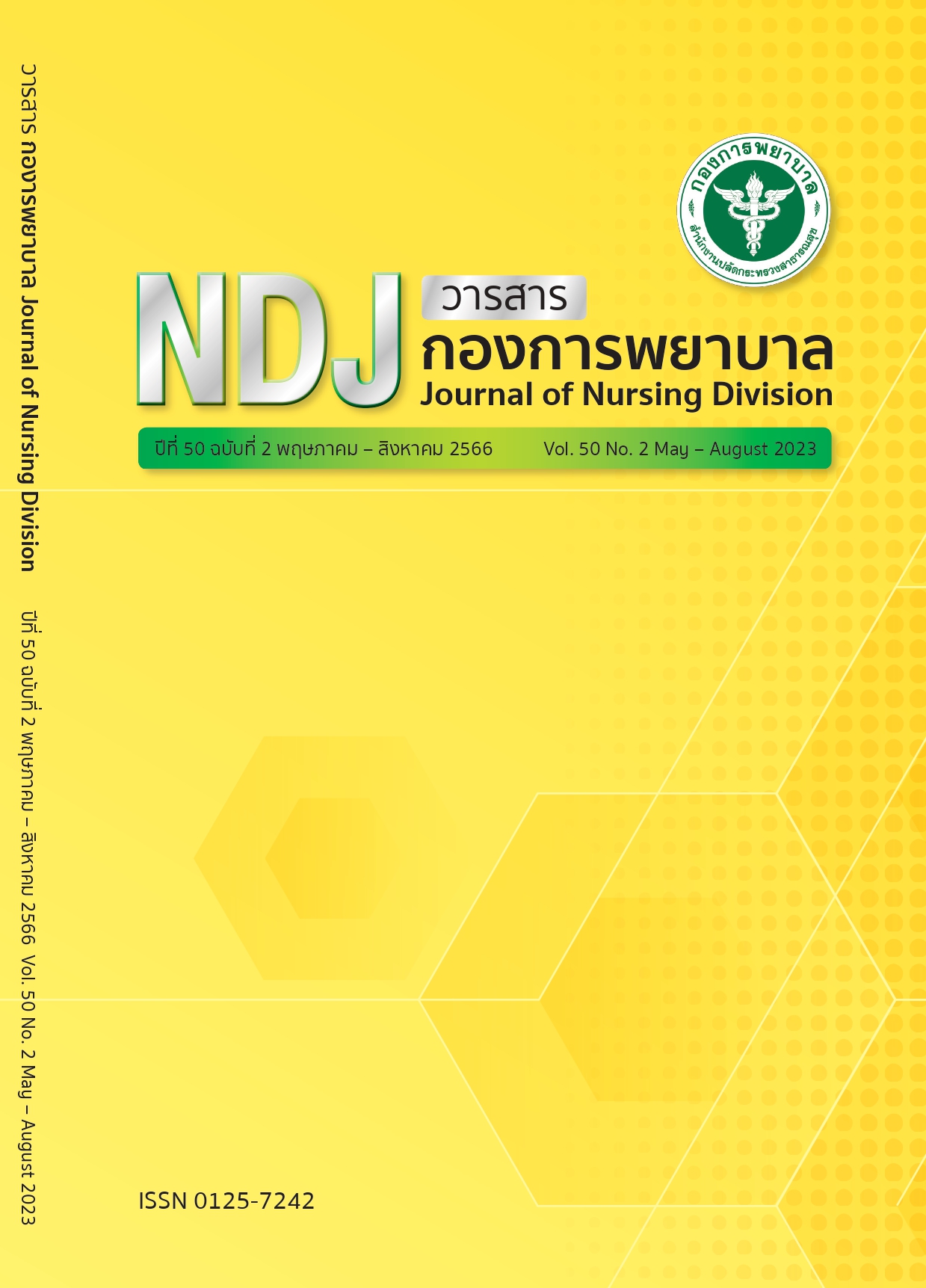อุบัติการณ์และปัจจัยที่เกี่ยวข้องของภาวะสับสนเฉียบพลันในผู้ป่วยสูงอายุที่รับการรักษาในโรงพยาบาลนพรัตนราชธานี
Main Article Content
บทคัดย่อ
บทคัดย่อ
ภาวะสับสนเฉียบพลัน เป็นหนึ่งในกลุ่มอาการสำคัญในผู้สูงอายุที่เข้ารับการรักษาในโรงพยาบาล ส่งผลกระทบหลายด้านทั้งต่อผู้ป่วยและหน่วยงานที่ให้การดูแลผู้สูงอายุ การศึกษานี้มีวัตถุประสงค์ เพื่อศึกษาอุบัติการณ์และปัจจัยที่เกี่ยวข้องของภาวะสับสนเฉียบพลันในผู้ป่วยสูงอายุที่รับการรักษาในโรงพยาบาลนพรัตนราชธานี เป็นการศึกษาไปข้างหน้าเชิงพรรณนา โดยเก็บข้อมูลผู้ป่วยที่มีอายุ 60 ปี หรือมากกว่า ที่เข้ารับการรักษาในแผนกอายุรกรรม แผนกศัลยกรรม และแผนกศัลยกรรมกระดูก จำนวน 343 คน ตั้งแต่ เดือนมิถุนายน ถึงเดือนสิงหาคม 2563 โดยใช้แบบประเมินภาวะสับสนเฉียบพลันและปัจจัยที่เกี่ยวข้อง วิเคราะห์ข้อมูลโดยใช้สถิติเชิงพรรณนา
ผลการศึกษา พบว่า ผู้สูงอายุที่ศึกษา เกิดภาวะสับสนเฉียบพลัน ร้อยละ 5 อยู่ในช่วงอายุ 80-89 ปี ร้อยละ 58.8 โดยเกิดช่วงวันที่ 1 ถึงวันที่ 4 ของการรักษาในโรงพยาบาล เกิดอาการทั้งกลางวัน และกลางคืน ร้อยละ 52.9 การเกิดภาวะสับสนเฉียบพลันมีปัจจัยร่วมกันที่พบบ่อย ได้แก่ สิ่งแวดล้อมในการดูแลรักษา ภาวะโรคเรื้อรังที่เป็นอยู่เดิม และภาวะเจ็บป่วยเฉียบพลันที่เข้ารักษาในโรงพยาบาล ตามลำดับ และยังพบว่ากลุ่มตัวอย่างทุกรายมีปัจจัยที่เกี่ยวข้องมากกว่า 2 อย่างขึ้นไป ผลการศึกษาครั้งนี้ช่วยให้บุคลากรทีมสุขภาพเข้าใจถึงการเกิดภาวะสับสนเฉียบพลัน ในผู้สูงอายุที่เข้ารับการรักษาในโรงพยาบาล และเป็นข้อมูลพื้นฐานในการพัฒนาแนวปฏิบัติที่เหมาะสมในการจัดการภาวะสับสนเฉียบพลันในผู้สูงอายุที่เข้ารักษาในโรงพยาบาลต่อไป
Article Details

อนุญาตภายใต้เงื่อนไข Creative Commons Attribution-NonCommercial-NoDerivatives 4.0 International License.
เอกสารอ้างอิง
Reference
Secretariat of the House of Representatives. Aging society and driving the Thai economy. [Internet]. 2021 [cited 2022 Apr 25]; Available from: https://www.dop.go.th/download/ knowledge/ th1617171499-823_0.pdf. Thai.
National Statistical Office. The 2021 survey of the older persons in Thailand. [Internet].2022 [cited 2023 Aug 29]; Available from: http://www.nso.go.th/sites/2014en/Survey/social/domographic/ OlderPersons/2021/fullreport_64.pdf. Thai.
National Statistical Office. Press release what statistics say present and future seniors. [Internet]. 2018 Apr 10 [cited 2022 Apr 25]; Available from: http://www.nso.go.th/sites/2014/Pages/ Press_Release/2561/N10-04-61-1.aspx. Thai.
Tipanetr Ngamkala, Porntip Malathum, Orapitchaya Krairit. Incidence and Risk Factors of Acute Confusional State in Hospitalized Older Patients. Ramathibodi nursing journal. [serial online] 2018 Oct. [cited 2022 Apr 25]; 24(4) :137-149 Available from: https://he02.tci-thaijo.org/index.php/RNJ/ article/view/148777. Thai.
Pannee Chaiwong, Kanokphon Sukhamwang, Rojanee Jintanawat, Nahathai Wongpakaran. Predictive factors for acute delirium in the elderly after surgery. Nursing journal CMU. 2558;42(2):116-125. Thai.
Srisoraluk Sumongkol, Naiyana Pipatwanicha, Pornchai Julmett. Factors related to postoperative delirium in older Adults undergoing spinal surgery. [Internet]. 2018 [cited 2020 Apr 10] ; Available from: http://rtunc2018.rtu.ac.th/. Thai.
Kobkaew Thongtid. Acute disorientation in the elderly after surgery. [thesis]. Khon Kaen: Khon Kaen University; 2010. Thai.
Nitikul Boonkaew. Nursing Care of Delirium in Older Person Patients Who Have Intensive Care, Undergoing Surgery and Palliative Care. [Internet] .2018 [cited 2022 Apr 25]; Available from: https://he01.tci-thaijo.org/index.php/EAUHJSci/article/download/134678/105491/379019. Thai.
Ali S, Patel M, Jabeen S, Bailey RK, Patel T, Shahid M, et al. Insight into Delirium. [Internet] 2011 [cited 2020 April 25]; Available from: https://www.researchgate.net/publication/ 51844784_ Insight_into_Delirium.
Weerasak Muangpaisarn. Prevention of acute disorientation in the elderly. [Internet]. 2013 Dec 13 [cited 2020 Apr 25]; Available from: https://www.si.mahidol.ac.th/sidoctor/e-pl/articledetail. asp?id=418. Thai.
National Institute for Health and Clinical Excellence. Delirium: diagnosis, prevention and management. National Clinical Guideline Centre. 2010; 103:1-33.
Nahatai Wongpakaran. Confusion Assessment Method (CAM). [Internet]. Chiangmai: Faculty of Medicine, Chiangmai University; 2008 [cited 2020 Apr 26]. Available from: www.wongpakaran.com/index.php?lay=show&ac=article&Id=2147570429.Thai.
Inouye, S.K. & Charpentier P.A. Precipitating factors for delirium in hospitalized elderly persons: predictive model and interrelationship with baseline vulnerability. JAMA Intern Med [serial online] 1996 Mar. [cited 2020 Apr 25]; 275(11): 852-7 Available from: https://jamanetwork.com/journals/jama/article-abstract/398635.
Kanokarn Kongpitee, Darawan Augsornwan, Wasitthe Setwong, Natthawadee Boonrueng, Parakorn Surakulprapa. Incidence and Predictive Factors for Post-operative Delirium among Older People. [Internet] 2019 sep 17 [cited 2020 Apr 25]; Available from: https://www.thaiscience.info/ Journals/Article/SRMJ/ 10994069.pdf. Thai.
Saxena S, Lawley D. Delirium in the elderly: a clinical review. Postgrad Med J [serial online] 2009 Aug. [cited 2020 Apr 25]; 85(1006): 405-13 Available from: https://pubmed.ncbi.nlm.nih.gov/ 19633006/.
Van den Boogaard M, Schoonhoven L, Van der Hoeven JV, Van Achterberg T, Pickkers. Incidence and short-term consequences of delirium in critically ill patients. International journal of nursing [serial online] 2012 Jul. [cited 2020 Apr 25] ; 49(7) : 775-83 Available from: https://www.sciencedirect.com/science/article/ abs/pii/S0020748911004603?via%3Dihub.
Kamonkan Preechatheerasat. A construction of a delirium risk factors screening tool for postoperative elderly patients. [thesis]. Bangkok: Chulalongkorn University; 2011. Thai.
Jintana Sinthusuwan. Predicting factors for acute disorientation in elderly patients admitted in the orthopedic surgery ward [thesis]. Bangkok: Chulalongkorn University; 2008. Thai.


